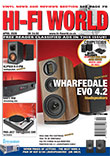Page 3 of 5
SOUND QUALITY The Opus 2 sounds in a nutshell big, powerful and exciting. It drew me in immediately; within minutes I was in a place that was very good audio wise. Portable players these days all do a good job and it is difficult for one to stand out but the Opus 2 did and sort of in the way expected of the ESS Sabre32 series DAC chips. Meaning it was organically rich and smooth, better textured in its sound than others. Tracks I play regularly for review purposes all grew; the voice of Lucia Gomez singing Lucia (24/96) was closer and more complex sounding: I found her more engaging than usual whilst the wooden block on one channel and accordion on the other had a stronger presence through sheer force of realism. All this is what I expect to hear from Sabre32 DACs well implemented. However, headphone drive chips and power supplies are an issue on portables, the latter little talked about, but low battery volts must be stepped up with modern dc-dc convertors and there's plenty of leeway to mess up here. I suspect it is in this critical area that TheBit have done a better job than most, allowing the 9018KM to really fly. Because another feature that grabbed me of this players sound was the width of the soundstage, and its sense of depth and airiness. It brought life to any rock music where a microphone(s) had been used (i.e. most rock!) and also to classical where I had some surprises.
Swiping down brings up this screen of basic player setting options.
Benjamin Grosvenor playing Chopin's Nocturne No 5 in F Sharp, Op 15, No2 (24/96) I usually pass over as a trifle bland in quality and not revealing enough for a sound quality assessment yet on the Opus 2 it sprung to life not only as a beautiful piece of music superbly played but as a live and atmospheric recording too, brimming with detail, the piano stretching wide across a generous soundstage that possessed air and space, with a depth perspective. This so captured my attention that I listened intently to a whole breadth of classical music and found the Opus 2 brought out low level detail and atmosphere like no other, making it especially strong in delivering choral works like Eric Whitacre Singers Oculi Omnium (24/96). The Opus 2 doesn't have the hard-etched sense of time domain progression of Astell&Kern players, so much as packing a powerful low-end punch and perfect timing, obvious with the metronomic drum machine in Queen's Radio GaGa. Tracks with a bit of a rough edge in the recording (24/96), like Tom Petty's Refugee were better sorted out in their structure, messiness unraveled to go easier on my ear; suddenly Refugee was made by humans in a studio rather than being a simulacrum hatched up on a cheap PC. And as the all-analogue 1965 recording of Otis Redding singing Respect (24/192) hove into aural view (as it were!) I felt as if I was listening in the Stax studio as the song was being laid down.
Track menu information is easy enough to read, with cover graphics depicted.
The Opus 2 threw up a big wide picture of what was going on, with deep insight into Redding at the microphone and the Memphis Horns acting as accompaniment. Judging the player in absolute terms by comparing it to an Audiolab M-DAC+, connected via optical digital cable, there wasnt the dynamic contrast available to acoustic bass, tenor sax or cornet in Duke Ellington's Stompy Jones (24/96) to take one example, but otherwise the Opus 2 had much of the svelte richness of the mains driven Audiolab, that also has an ESS 9018 DAC inside of course. I don't think it is realistic to expect a battery driven device to be comparable to a mains unit, so this is no deal breaker; the Opus 2 still had the essence of the Audiolab. Moving from listening with Philips Fidelio X1 headphones to Oppo PM1s that can be connected balanced, I found the balanced output lacked the low-end drive and punch of the headphone output and I suspect it is purposed as a line output that needs to see a higher load than phones. It still sounded nice and clear however, with great instrument separation across the midband and pin-sharp imaging. |
Search
Hi-Fi World, Powered by Joomla!; Hosted by Joomla Wired.








